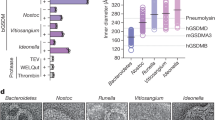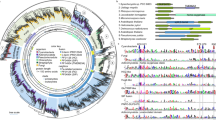Abstract
The soluble core domain of cytochrome b5 of liver endoplasmic reticulum was appended at its amino terminus to full-length alkaline phosphatase secretory signal sequence including the ribosomal binding site. The chimeric precursor gene was placed under the transcriptional control of the native pho promoter in a prokaryotic expression vector. Induction of Escherichia coli by growth in a phosphate-limited medium resulted in abundant synthesis of cytochrome b5 as detected spectrophotometrically and by visual transformation of the bacteria to a pink color. The signal-appended cytochrome b5, but not the corresponding signal-deficient derivative, was translocated across the bacterial inner membrane and processed to yield authentic, haem-assembled cytochrome b5 within the periplasm. The eventual processing of the chimeric cytochrome b5 precursor was unusual regarding the known reaction specificity of signal peptidase. The exported, mature haemoprotein was biochemically indistinguishable from its native mammalian counterpart. At peak induction, approximately 6 mg of correctly matured cytochrome b5 per liter of culture was exported. This amount of cytochrome b5 constituted 6% (w/w) of the periplasmic protein. The appearance of the exported apo-cytochrome b5 preceded the formation of holo-protein. Thus the eukaryotic cytoplasmic protein was efficiently exported from E. coli and post-translocationally modified to generate a functional haemoprotein in the periplasm.
This is a preview of subscription content, access via your institution
Access options
Subscribe to this journal
Receive 12 print issues and online access
$209.00 per year
only $17.42 per issue
Buy this article
- Purchase on Springer Link
- Instant access to full article PDF
Prices may be subject to local taxes which are calculated during checkout
Similar content being viewed by others
References
Stader, J.A. and Silhavy, T.J. 1990. Engineering Escherichia coli to secrete heterologous gene products. Methods in Enzymol. 185: 166–187.
Duffaud, G.Y., March, P.E. and Inouye, M. 1987. Expression and secretion of foreign proteins in Escherichia coli. Methods in Enzymol. 153: 492–507.
Dodt, J., Schmitz, T., Schäfer, T. and Bergman, C. 1986. Expression, secretion and processing of hirudin in E. coli using alkaline phosphatase signal sequence. FEBS Lett. 202: 373–376.
Fujimura, T., Tanaka, T., Ohara, K., Marioka, H., Uesugi, S., Ikehara, M. and Nishikawa, S. 1990. Secretion of recombinant ribonuclease T1, into the periplasmic space of Escherichia coli with the aid of the signal peptide of alkaline phosphatase. FEBS Lett. 265: 71–74.
Klein, B.K., Hill, S.R., Devine, C.S., Rowold, E., Smith, C.E., Galosy, S. and Olins, P.O. 1991. Secretion of active bovine somatotropin in Escherichia coli. Bio/Technology 9: 869–872.
Hsiung, H.M., Mayne, H.G. and Becker, G.W. 1986. High-level expression, efficient secretion and folding of human growth hormone in Escherichia coli. Bio/Technology 4: 991–995.
Tataki, H., Morinaga, Y., Tsuchiya, M., Ikemura, H. and Inouye, M. 1988. Control of folding of proteins secreted by a high level expression vector, pIN-III-ompA: 16-fold increase in production of active subtilisin E in Escherichia coli. Bio/Technology 6: 921–928.
Schenkman, J.B., Jansson, I. and Robie-Suh, M. 1976. The many roles of cytochrome b5 in hepatic microsomes. Life Sciences 19: 611–624.
Oshino, N., Imai, Y. and Sato, R. 1971. A function of cytochrome b5 in fatty acid desaturation in rat liver microsomes. J. Biochem. (Tokyo) 69: 155–167.
Roy, D., Strobel, H.W. and Liehr, J.G. 1991. Cytochrome b5-mediated redox cycling of estrogen. Arch. Biochem. and Biophys. 285: 331–338.
White, R.E. and Coon, M.J. 1980. Oxygen activation by cytochrome P-450. Ann. Rev. Biochem. 49: 315–356.
Matthews, F.S. and Czerwinski, E.W. 1986. Cytochrome b5 and cytochrome b5 reductase from a chemical and X-ray diffraction viewpoints. Vol 4, p. 143–197.In: The Enzymes of the Biological Membranes. A. Martonosi (Ed.). Plenum Press, New York.
Zhang, H. and Sommerville, C. 1990. Soluble and membrane-bound forms of cytochrome b5 are the products of a single gene in chicken. Arch. Biochem. Biophys. 280: 412–415.
Giordano, S.J. and Steggles, A.W. 1991. The human liver and reticulocyte cytochrome b5 mRNAs are products from a single gene. Biochem. Biophys. Res. Comm. 178: 38–44.
Beck von Bodman, S., Schuler, M.A., Jollie, D.R. and Sligar, S.G. 1986. Synthesis, bacterial expression, and mutagenesis of the gene coding for mammalian cytochrome b5 . Proc. Natl. Acad. Sci. USA. 83: 9443–9447.
Gallagher, J., Kaderbhai, N. and Kaderbhai, M.A. 1992. Gene-dose dependent expression of soluble cytochrome b5 in Escherichla coli. App. Microbiol. and Biotechnol. 38: 77–83.
Kaderbhai, M.A., Sligar, S.G., Barnfield, T., Reames, T., Gallagher, J., Mingyue, He, Mercer, E.I. and Kaderbhai, N. 1990. A novel series of pEX-PINK expression vectors for screening high-level production of (un)fused foreign proteins by rapid visual detection of PINK Escherichia coli. Nucleic Acids Res. 18: 4629–4630.
Kaderbhai, N., Gallagher, J. and Kaderbhai, M.A. 1992. A pink bacterium as a reporter system signalling expression of a recombinant protein. DNA Cell Biol. 11: 567–577.
Li, P., Beckwith, J. and Inouye, H. 1988 Alteration of the N-terminus of the mature sequence of a periplasmic protein can severely affect protein export in Escherichia coli. Proc. Natl. Acad. Sci. USA. 85: 7685–7689.
Estabrook, R.W. and Werringloer, J. 1978. The measurement of difference spectra. Methods in Enzymol. 52: 212–220.
Hirel, P.H., Schmitter, J.M., Dessen, P., Fayat, G. and Blanquet, S. 1989. Extent of amino terminal methionine excision from Escherichia coli proteins is governed by the side-chain length of the penultimate amino acid. Proc. Natl. Acad. Sci. USA. 86: 8247–8251.
Hopper, D.J., Jones, M.R. and Causer, M.J. 1985. Periplasmic location ofp-cresolmethylhydmxylas in Pseudomonas putida. FEES Lett. 182: 485–488.
Chang, C.N., Kuang, W-J. and Chen, E.Y. 1986. Nucleotide sequence of the alkaline phosphatase gene of Escherichia coli. Nucleic Acids Res. 44: 121–125.
Walter, P., Gilmore, R. and Blobel, G. 1984. Protein translocation across the endoplasmic reticulum. Cell 38: 5–8.
Takahara, M., Sagai, H., Inouye, S. and Inouye, M. 1988. Secretion of human superoxide dismutase in Escherichia coli. Bio/Technology 6: 195–198.
Barra, D., Martini, F., Bannister, J.V., Schinina, M.E., Rotilio, G., Bannister, W.H. and Bossa, F. 1980. The complete amino acid sequence of human Cu/Zn superoxide dismutase. FEBS Lett. 120: 53–56.
Hjalmarsson, K., Marklund, S.L., Engstroem, A. and Edlund, T. 1987. Isolation and sequences of complementary DNA encoding human extracellular superoxide dismutase. Proc. Natl. Acad. Sci. USA. 84: 6340–6344.
Moore, C.D., Al-Misky, O.N. and Lecomte, J.T.J. 1991. Similarities in structure between holocytochrome b5 and apocytochrome bs: NMR studies of the histidine residues. Biochemistry 30: 8357–8365.
Collier, D.N., Bankaitis, V.A., Weiss, J.B. and Bassford, P.J. 1988. The anti-folding activity of SecB promotes the export of Escherichia coli maltose-binding protein. Cell 53: 273–283.
Wickner, W., Driessen, A.J.M. and Hartl, F-U 1991. The enzymology of protein translocation across the Escherichia coli plasma membrane. Ann. Rev. Biochem. 60: 101–124.
Sjöstörm, M., Wold, S., Wieslander, Å. and Rilfors, L. 1987. Signal peptide amino acid sequence in Escherichia coli contain information related to final protein localization. A multivariate data analysis. EMBO J. 6: 823–831.
von Heijne, G. 1990. The signal peptide. J. Memb. Biol. 115: 195–201.
Dev, I.K. and Ray, P.H. 1990. Signal peptidases and signal peptide hydrolases. J. Bioener. Biomembr. 22: 271–290.
Georgiou, G., Telford, J.N., Shuler, M.L. and Wilson, D.B. 1986. Localization of inclusion bodies in Escherichia coli overproducing β-lactamase or alkaline phosphatase. Appl. Environ. Microbiol. 52: 1157–1161.
Bowen, G.A., Paredes, A.M. and Georgiou, G. 1991. Structure and morphology of protein inclusion bodies in Escherichia coli. Bio/Technology 9: 725–730.
Anba, J., Pages, J-M., Bemadac, A. and Lazdunski, C. 1987. New insights into the export machinery through studies on the synthesis of phosphate-binding protein in Escherichia coli, p. 73–77. In: Phosphate Metabolism and cellular Regulation in Microorganisms. A. Torriani-Gorrini, F. G. Rothman, S. Silver. A. Wright, and E. Yagil (Eds.). American Soc. Microbiol., Washington DC.
Shortle, D. 1983. A genetic system for analysis of staphylococcal nuclease. Gene 22: 181–189.
Maniatis, T., Fritsch, E.F. and Sambrook, J. 1989. Molecular Cloning. A Laboratory Manual. Cold Spring Harbor Laboratory, Cold Spring Harbor. New York.
Sanger, F., Nicklen, S. and Coulson, A.R. 1977. DNA sequencing with chain termination inhibitors. Proc. Natl. Acad. Sci. USA. 74: 5463–5467.
Torriani, A. 1967. Alkaline phosphatase from Escherichia coli p. 224–235. In: Procedures in Nucleic Acid Research. G. L. Cantoni, D. R. Davies (Eds.). Harper and Row Publishers, New York.
Moore, A.L. and Proudlove, M.O. 1983. Mitochondnal and sub-mitochondrial particles, p. 153ndash;184. In: Isolation of Membranes and Organellcs from Plant Cells. J. L. Hall and A. L. Moore (Eds.). Academic Press, New York.
Hultquist, D.E. 1978. Methemoglobin reduction system of erythrocytes. Methods in Enzymol. 52: 463–473.
Bradford, M. 1976. A rapid and sensitive method for quantification of micro-gram quantities of protein utilizing the principle of protein-dye binding. Anal. Biochem. 72: 248–254.
Author information
Authors and Affiliations
Rights and permissions
About this article
Cite this article
Karim, A., Kaderbhai, N., Evans, A. et al. Efficient Bacterial Export of a Eukaryotic Cytoplasmic Cytochrome. Nat Biotechnol 11, 612–618 (1993). https://doi.org/10.1038/nbt0593-612
Received:
Accepted:
Issue Date:
DOI: https://doi.org/10.1038/nbt0593-612



